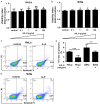Hypoxia promotes the proliferation of cervical carcinoma cells through stimulating the secretion of IL-8
- PMID: 24551277
- PMCID: PMC3925901
Hypoxia promotes the proliferation of cervical carcinoma cells through stimulating the secretion of IL-8
Abstract
To explore whether hypoxia and interleukin 8 (IL-8) regulate the viability and apoptosis of cervical carcinomas cells and the possible mechanism. We evaluated the expression of hypoxia inducible factor-1α (HIF-1α), IL-8 and its receptors (CXCR1 and CXCR2) in cervical cancer and cervicitis tissues by immunohistochemistry. Then the effects of hypoxia and IL-8 on the viability and apoptosis of HeLa and SiHa cells were detected by the SRB and apoptosis assays. Here we observed that the expression of HIF-1α, IL-8 and CXCR1 in cervical cancer tissues was significantly higher than that in cervicitis tissues. Hypoxic condition stimulated the secretion of IL-8 and the expression of CXCR1 and CXCR2 on HeLa and SiHa cells. Recombinant human IL-8 enhanced the viability and reduced the apoptosis in HeLa and SiHa cells. HeLa and SiHa cells cultured in 1% oxygen showed the increased viability and apoptosis, and the former effect could be partly reversed by anti-human IL-8 neutralizing antibody. This data suggested that IL-8 secreted by cervical carcinomas cells induced by hypoxia can stimulate the viability of cervical carcinomas cells in an autocrine dependent manner, and contribute to the pathogenesis of cervical cancer.
Keywords: Hypoxia; IL-8; apoptosis; cervical carcer cells; viabilty.
Figures





Similar articles
-
Hypoxia-inducible erythropoietin signaling in squamous dysplasia and squamous cell carcinoma of the uterine cervix and its potential role in cervical carcinogenesis and tumor progression.Am J Pathol. 2003 Jun;162(6):1789-806. doi: 10.1016/S0002-9440(10)64314-3. Am J Pathol. 2003. PMID: 12759237 Free PMC article.
-
HIF-1 and NF-kappaB-mediated upregulation of CXCR1 and CXCR2 expression promotes cell survival in hypoxic prostate cancer cells.Oncogene. 2007 Nov 15;26(52):7333-45. doi: 10.1038/sj.onc.1210536. Epub 2007 May 28. Oncogene. 2007. PMID: 17533374
-
[Expression and clinical significance of Dyrk1b in the specimens and cells of cervical lesions].Zhonghua Fu Chan Ke Za Zhi. 2016 Jan;51(1):40-5. doi: 10.3760/cma.j.issn.0529-567X.2016.01.010. Zhonghua Fu Chan Ke Za Zhi. 2016. PMID: 26899006 Chinese.
-
Interleukin-8/CXCL8 is a growth factor for human lung cancer cells.Br J Cancer. 2004 Nov 29;91(11):1970-6. doi: 10.1038/sj.bjc.6602227. Br J Cancer. 2004. PMID: 15545974 Free PMC article.
-
How does hypoxia inducible factor-1α participate in enhancing the glycolysis activity in cervical cancer?Ann Diagn Pathol. 2013 Jun;17(3):305-11. doi: 10.1016/j.anndiagpath.2012.12.002. Epub 2013 Feb 1. Ann Diagn Pathol. 2013. PMID: 23375385 Review.
Cited by
-
SYKT Alleviates Doxorubicin-Induced Cardiotoxicity via Modulating ROS-Mediated p53 and MAPK Signal Pathways.Evid Based Complement Alternat Med. 2018 Aug 26;2018:2581031. doi: 10.1155/2018/2581031. eCollection 2018. Evid Based Complement Alternat Med. 2018. PMID: 30224925 Free PMC article.
-
C-X-C motif chemokine ligand 8 promotes endothelial cell homing via the Akt-signal transducer and activator of transcription pathway to accelerate healing of ischemic and hypoxic skin ulcers.Exp Ther Med. 2017 Jun;13(6):3021-3031. doi: 10.3892/etm.2017.4305. Epub 2017 Apr 5. Exp Ther Med. 2017. PMID: 28587375 Free PMC article.
-
The Effect of Hypoxia on the Expression of CXC Chemokines and CXC Chemokine Receptors-A Review of Literature.Int J Mol Sci. 2021 Jan 15;22(2):843. doi: 10.3390/ijms22020843. Int J Mol Sci. 2021. PMID: 33467722 Free PMC article. Review.
-
Nonphosphorylatable PEA15 mutant inhibits epithelial-mesenchymal transition in triple-negative breast cancer partly through the regulation of IL-8 expression.Breast Cancer Res Treat. 2021 Sep;189(2):333-345. doi: 10.1007/s10549-021-06316-2. Epub 2021 Jul 9. Breast Cancer Res Treat. 2021. PMID: 34241740 Free PMC article.
-
Paracrine interleukin-8 affects mesenchymal stem cells through the Akt pathway and enhances human umbilical vein endothelial cell proliferation and migration.Biosci Rep. 2021 May 28;41(5):BSR20210198. doi: 10.1042/BSR20210198. Biosci Rep. 2021. Retraction in: Biosci Rep. 2021 Dec 22;41(12):BSR-2021-0198_RET. doi: 10.1042/BSR-2021-0198_RET. PMID: 33843989 Free PMC article. Retracted.
References
-
- Forouzanfar MH, Foreman KJ, Delossantos AM, Lozano R, Lopez AD, Murray CJ, Naghavi M. Breast and cervical cancer in 187 countries between 1980 and 2010: a systematic analysis. Lancet. 2011;378:1461–1484. - PubMed
-
- Arbyn M, Castellsagué X, de Sanjosé S, Bruni L, Saraiya M, Bray F, Ferlay J. Worldwide burden of cervical cancer in 2008. Ann Oncol. 2011;22:2675–2686. - PubMed
-
- Dachs GU, Chaplin DJ. Microenvironmental control of gene expression: implications for tumor angiogenesis, progression, and metastasis. Semin Radiat Oncol. 1998;8:208–216. - PubMed
-
- Semenza GL. Targeting HIF-1 for cancer therapy. Nat Rev Cancer. 2003;3:721–732. - PubMed
-
- Lee WY, Huang SC, Hsu KF, Tzeng CC, Shen WL. Roles for hypoxia-regulated genes during cervical carcinogenesis: somatic evolution during the hypoxia-glycolysis-acidosis sequence. Gynecol Oncol. 2008;108:377–384. - PubMed
